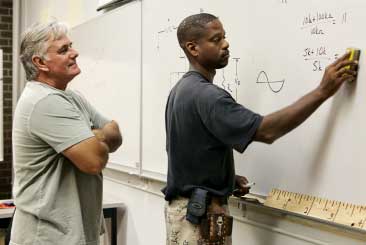|
|
| "There’s one in every group!" Part II - Defuse interruptions during training |
| By Joe Bouchard |
| Published: 06/15/2009 |
 In part I of "There’s one in every group!" we defined major training interrupters. There are five major perpetrators of Instruction Interruptus, a veritable A-list of discourtesy. They are the Inpatient Information Seeker, the Attention Monger, the Apple Polisher, the Loquacious, and he Malevolent. Now let’s look at some of the damage caused by these A-list disruptors.
In part I of "There’s one in every group!" we defined major training interrupters. There are five major perpetrators of Instruction Interruptus, a veritable A-list of discourtesy. They are the Inpatient Information Seeker, the Attention Monger, the Apple Polisher, the Loquacious, and he Malevolent. Now let’s look at some of the damage caused by these A-list disruptors.
So, what is the big deal about a few seemingly innocuous interruptions? Does it really matter in the bigger scheme of things? It typically turns out that short asinine outbursts are cumulative and can become major disruptions. It goes beyond halting instruction for a few seconds. There are many ill effects. Valuable time is taken away from the scheduled topic. This is often done without considering the large expense involved in training staff. The speaker becomes frustrated and, therefore, less effective. A group of formerly placid students can become harder to manage and direct. Animosity can fester and reach beyond the class room. If the interrupter is especially aggravating, avenging students may address the discourtesy with harassment and/or violence at a later time. Others can ostracize the interrupters. This is the gateway for staff division and the set up. But even with the ill effects of interruptions in the classroom, there is hope for the trainer. Here are a few strategies to employ to counter all varieties of lecture interruptus. Provide pens and papers. Tell participants to record all comments and questions. They will be reviewed and addressed at the end of the session. When the trainer is being bullied, it may end quickly by employing some counter-coercion. However, this has to be done tactfully and within the bounds of policy, procedure, and work rule. Too much pressure, no matter how tempting, may unnecessarily humiliate the initial aggressor. That could also force the class to turn against the instructor. Maintain a healthy sense of humor. If you take yourself too seriously, the audience will dismiss you as pompous and humorless. Enjoy the proper level of dignity, but in balance with levity. Temporarily shine the spotlight on the heckler. Pose questions back to the interrupter. Propose a hypothetical query that fits the point for the interrupter to solve. Keep participants busy. Maintain a list of labor-intensive icebreakers or classroom exercises to alleviate tension and boredom. Give the interrupter a job. Assign the would-be adversary a useful opportunity to solve a problem. Reward a boisterous zealot with a committee position if you have the position to do so. That could be a useful harnessing of energy. Write a broad outline on the board. Check off each item covered as the lesson progresses. This shows topics in order of appearance and may divert interruptions to more appropriate times. Timing is important. Intervene at the right time. Most of the audience is looking to you for direction and leadership. Look at yourself as an instructor. Does your training style invite interruptions? Approach the heckler when there is no audience. Tactfully outline your concerns and propose a solution. The interrupter may not even know that the behavior is disruptive. On some days, trainers will utilize all audience management skills that they have learned. So, it is important to remember a number of caveats. An important caution is to remember the art of balance and caution. Also, not all remedies will work for all situations. And rough verbal camaraderie could be construed by some as harassment. It is critical to know your audience as much as possible. The instructor, while often forced to be instantly creative, must stay within the bounds of policy and procedure. And a little levity goes a long way in relieving the tension of a training room. Corrections professionals stay sharp and focused through training. It is certain that interruptions will continue as long as classrooms exist. However, it is up to the instructor to recognize and repair the distraction for the good of the entire class. Training is meant for everyone in team corrections. The trick is to include, rather than exclude the five varieties of interrupters. These are the opinions of Joe Bouchard, a Librarian employed with the Michigan Department of Corrections. These are not necessarily the opinions of the Department. The MDOC is not responsible for the content or accuracy. Visit the Joe Bouchard page |
Comments:
Login to let us know what you think
MARKETPLACE search vendors | advanced search

IN CASE YOU MISSED IT
|


In this time we have need to save our time for the other work because if we waste remote desktop windows 10 home our time then we can not work properly.